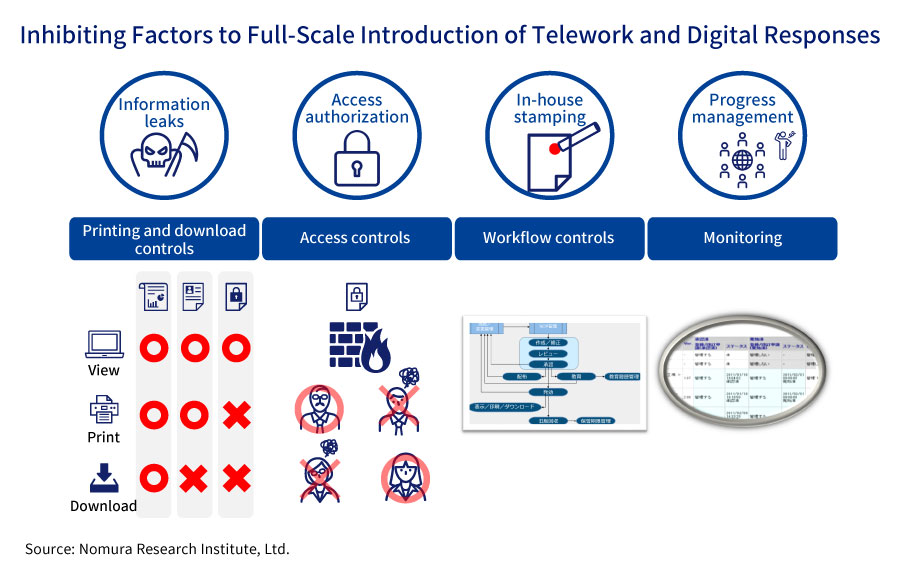
Promoting Telework with Proper Document Management -- Avoiding the Risk of Information Leaks with Digital Technology
The impact of Covid-19 has led more and more companies to introduce telework and work-from-home options. Meanwhile, it has become clear that many employees are forced to physically come to work due to the nature of their work and the inadequacy of the IT environment. In particular, various problems brought about by the deep-rooted paper culture in Japanese society have been thrown into sharp relief. We talked with Yusuke Chonan of Nomura Research Institute (NRI), who has been involved for many years in electronic document management consulting to resolve these issues.
Paper culture practices that impede telework
--- Please tell us about the status of telework adoption at companies.
According to the results of a survey conducted by the Japan Business Federation (Keidanren) in April 2020, more than 90% of companies introduced telework and work-from-home options after the announcement of the state of emergency. However, Keidanren estimates that more than 30% of employees are attending work in person. This is because even if you have an IT environment that connects from home to your company’s network and you are working with electronic files, you need an approval stamp because the physical paper version is the original. In addition, in the CIO (Chief Information Officer) survey conducted by NRI in May, paperless offices, remote work, and digitalization of stamping processing were ranked high as measures of increasing priority of late.
--- Why does paper culture persist despite the progress of digitization throughout the society?
As mentioned earlier, the paper documents start off as electronic files, so there are no issues with digitization itself. It is the companies’ “culture” of having worked on paper for many years that is significant. Even if you clear this hurdle, there are still issues, namely ones involving original document management and countermeasures against falsification and other unauthorized use that can occur due to digitization. These topics are discussed in an NRI Journal * article from September 2, 2019. Furthermore, there are the issues of information leaks and replacing in-house stamping with signature records.
Information leak prevention by controlling downloading and printing
--- What are the problems with simply creating digital substitutes for current processes?
For example, suppose that your confidential information is managed so that the people who can view it are limited, it can only be viewed on paper when in the office, and it cannot be taken out. Assuming that you were to replace this with electronic files, if a teleworking employee with viewing authorization wants to see confidential documents at home, they can save the data to their PC, attach it to an email, or print it on paper and give it to someone. This increases the risk of information leaks.
--- Is there a way to prevent information leaks during digitalization?
Digital technology is advancing, and there are already systems in the world that have functions to prevent unauthorized use such as information leaks and falsification. For example, NRI’s document management system “Perma Document” has a restriction function that allows files to be viewed only on the screen of a PC and prevents them from being downloaded or printed. Additionally, if you tell people outside the company only the “file URL” instead of sending the document via e-mail or the like, even if the URL leaks, users who cannot log in will not be able to see the document, so information can be shared safely. Furthermore, if you use the function that keeps electronic signature records in the workflow and you can see the approval status of the related people at a glance, you do not have to go to the office to have them stamp it.

--- Wouldn’t large digital investments be required to take advantage of those features?
In the past, initial investment was required, such as system development and purchasing servers, so there may have been a hesitancy towards introduction in terms of cost. However, cloud services have become widespread recently, and the hurdles for introduction have been considerably lowered. It can be said that these features are now readily available to not only large companies with financial means but also small and medium-sized companies. Therefore, going forward, I think it is advisable to consider what functions are needed on the assumption that all employees will utilize telework.
Opportunities for operational efficiency and sophistication
--- Please give us some advice for promoting telework.

Speed is very important to prepare for the second and third waves of the new coronavirus. You can start using cloud-based services immediately. Services with monthly billing plans are increasing, making it possible to flexibly review usage. However, as long as you use an off-the-shelf service, there will always be places where you have to match your own operations to the specifications of the service. If you are particular about tailoring a service your company, you will not be able to respond quickly. It is essential to have an attitude of trying to make good use of existing services while flexibly reviewing existing business processes.
This climate where changes are easily tolerated because of the coronavirus crisis is a great opportunity to improve the efficiency and sophistication of operations. It is important to move forward without fear of change. We at NRI also regard 2020 as the first year of the age of telework in terms of workstyle reform, and would like to continue to support it.
- * September 2, 2019, “Document Management that Guarantees Protection of Companies and Ensures the Quality of Products and Services” ( https://www.nri.com/jp/journal/2019/0902 )
Profile
-
Yusuke Chonan
* Organization names and job titles may differ from the current version.